USPTO Update:Trademark Public Advisory Committee (TPAC) Quarterly Meeting
Nehal Madhani | April 14, 2022
On April 8, 2022, the USPTO held the Trademark Public Advisory Committee (TPAC) Quarterly Meeting, reviewing policies, goals, performance, budget, and user fees, among other important topics. This article provides a summary of key highlights from the meeting. Check out our summary of the Q1 2022 TPAC Quarterly Meeting.
Trademark Management Report
Commissioner for Trademarks David Gooder began with a Trademarks Management Report. He noted that at this point in FY2022, trademark application filing levels are healthy, but are a notch below last year. He explained that the application filing levels in 2021 were so abnormally high that current numbers can’t compare with 2021 numbers. However, as compared with FY2020, FY2022 application filing levels are still up 18%. Thus far, new filings are on par with the growth that the USPTO has seen over the years.
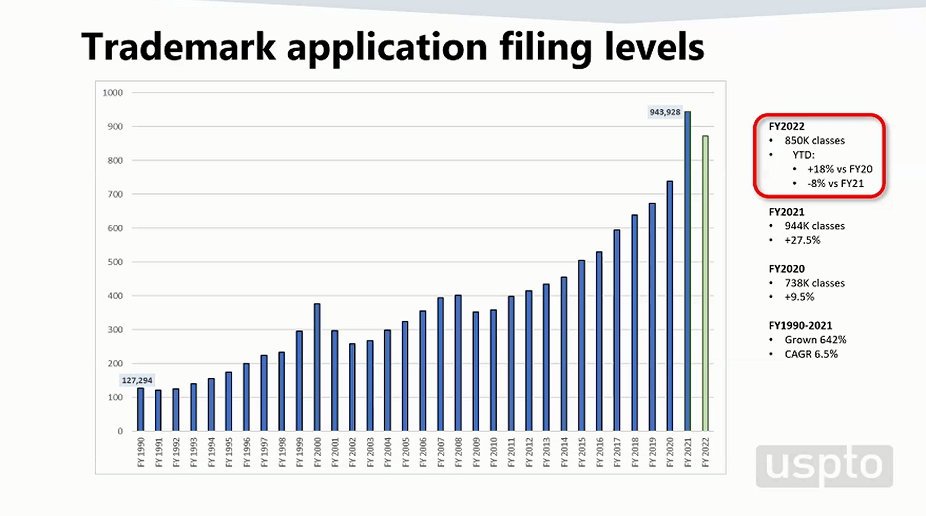
Commissioner Gooder shared a chart showing trademark applications filed by month over the course of several years. The chart showed that in the first five months of any given fiscal year, filings are lower and then from March through the summer months, filings tend to increase. This trend has been consistent going back to FY2013. Filings in November and December 2021 were lower due to increased filings in FY2021.
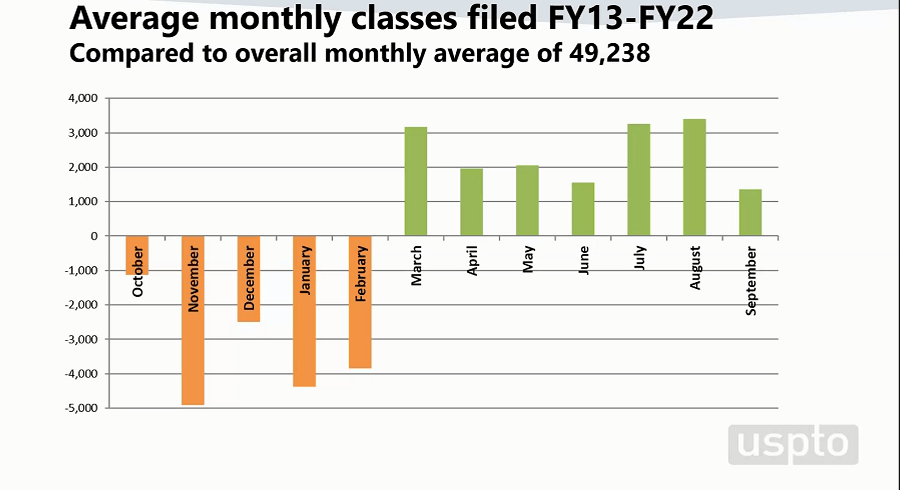
In terms of where new applications are originating, US-based applications are slightly up. After spikes in September-December last year, China-based applications are down to about 16%, bringing the current number of China-based applications to where it has been historically over the past 5 years. As a result of the drop in China-based applications, the percentage of filings based both in the EU and the rest of world are slightly up.
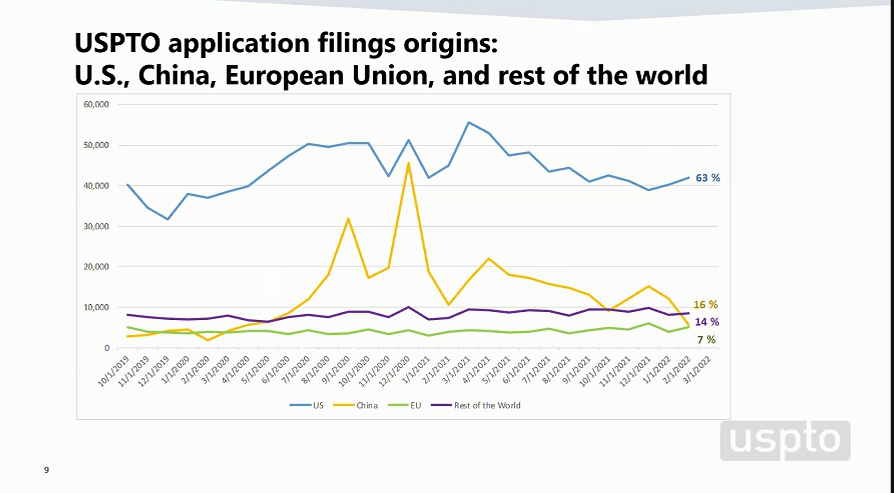
When comparing the number of classes filed in FY2022 to FY2021, both US and China are slightly lower than last year, but are still showing very healthy numbers. Filings coming from Europe and the Americas are also very healthy.
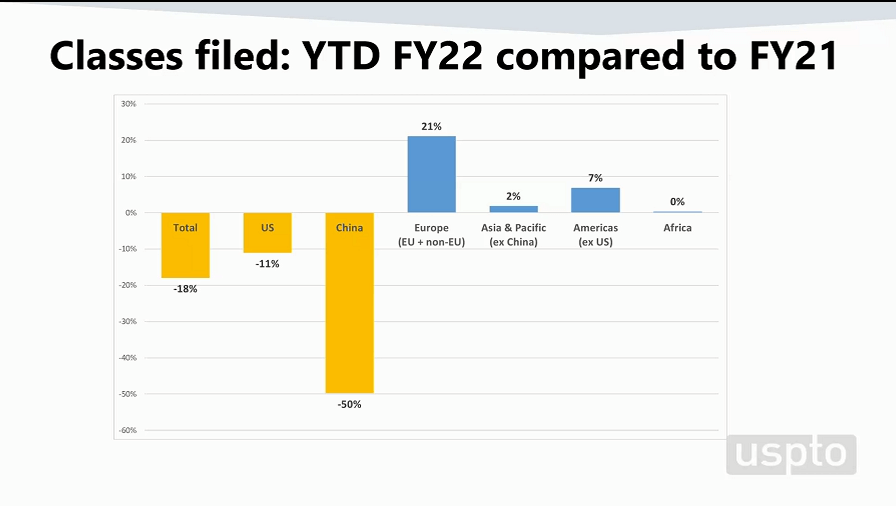
Commissioner Gooder reported that in order to handle the increase in filings, the USPTO has continued to increase trademark staffing. The USPTO Trademarks office employs 1,084 employees, including 735 examiners. While the USPTO is still in a state of maximum telework, the Department of Commerce has issued a notice that USPTO will move to Phase 3 on May 25 where employees can go to the building and have visitors. The vast majority of employees who worked via telework prior to the pandemic will continue working via telework.
Financial Status Update
Chief Financial Officer Jay Hoffman discussed trademark pendency. He noted that the current total pendency is 12.5 months and the goal is 13.5 months. The first action pendency is currently at 7.6 months and the goal is 7.5 months. Hoffman explained that strong application filings have caused an increase in the pendency, but the hope is that the curves will flatten out in the near to mid-term.
Trademarks FY2022 Priorities Update
Commissioner Gooder identified three major areas where the USPTO is prioritizing its efforts:
EU anti-scam network meeting
As scams grow in sophistication and frequency, the USPTO has pivoted with how they are dealing with scams. More of the scams are coming from international venues – two very notable ones came from China and Pakistan. There was also a recent criminal action where a Latvian defendant is serving jail time. The USPTO met with all of the EU countries including Europol to exchange information. While the US is dealing with fraud on a larger scale than the EU, the cooperation is important for both sides.
Electronic registration certificates
The USPTO has been receiving requests from customers over the years to issue electronic registration certificates. The USPTO prints around 8,000 certificates each week – it’s a lot of paper, printing, effort, etc. and customers have said that they don’t really need the paper. The USPTO is on target to move to electronic registration certificates for applications filed on/after May 31, 2022 and registration certificates will be issued with a digital seal. Customers will still be able to purchase a printed copy (presentation copy).
ID Verification
The USPTO has been a very open system over the years, but with increases in fraud (applications containing false and fraudulent information) and scams, ID verification is necessary.
ID Verification Process
Deputy Commissioner for Trademark Examination Policy, Amy Cotton explained the various phases involved in ID Verification.
Phase 1 – Requiring MyUSPTO name/password (Complete)
What it does: Tracks improper submissions, linking them to accounts that the USPTO can then block.
What it does NOT do:
- It does not prevent users from creating new accounts because the USPTO does not verify identity at this stage.
- It does not prevent unauthorized persons from submitting filings on behalf of or in place of other parties.
- It does not prevent multiple individuals from using one USPTO.gov account.
Phase 2 – Requiring ID Verification (current phase)
We are now in Phase 2, a voluntary phase, which helps the USPTO to ensure that the one person with the USPTO.gov account is who they say they are and that they are accountable for whatever activities they are doing in front of the office. Once this phase becomes mandatory, it will help the USPTO to prevent new accounts from being created. Account holders will have to identify their role so unauthorized parties won’t be able to have a USPTO.gov account and file submissions. However, this phase does not prevent ID verified but unauthorized persons from filing submissions on specific applications or registrations.
Phase 2 has a user role component. When verifying your account, you must assign yourself to one of the four user roles. If you are verifying your account and do not fit into one of these categories, you are not authorized to make submissions to the USPTO. The USPTO noted that they are planning a webinar on user roles.
Owner – A person who is an individual and the owner of the mark; a person who can legally bind the owner to any obligation and/or agreement (e.g. a corporate officer); a person who is employed by a juristic entity owner.
US-Licensed Attorney – Active member in good standing of the highest court of any US state, Commonwealth or territory, or DC.
Canadian Attorney or Agent – A practitioner reciprocally recognized by the USPTO’s OED to represent persons in Canada before the USPTO in trademark matters.
Attorney Support Staff – US- or Canadian-licensed attorneys may sponsor individuals with USPTO.gov accounts. These individuals must be verified by the attorney and the attorney is then responsible to all activities the support staff is engaged in.
Phase 3 – Access Controls
Phase 3 will prevent hijacking and ensure that owners will only be able to touch files that they own and not on anyone else’s applications or submissions. Attorney accounts will have access only for files where they are attorneys of record. Attorney support staff will only have access to files where the sponsoring attorney is the attorney of record. This phase will ensure that the USPTO knows who it is interacting with and allow the USPTO to lock out people who they do not want to interact with.
Operations Update
Deputy Commissioner for Trademark Operations, Dan Vavonese, provided an Operations Update. He began by displaying a chart showing the unexamined application inventory. He explained that there has been a welcome respite after the influx of filings in 2021. The USPTO has seen a decrease in filings from 2021, but there is still an 18% increase in filings over the past two years and a 9% increase over 2020 filings. Overall, there is still an increase in filings and the USPTO is expecting approximately 850,000 classes to be filed in FY2022. As a result, unexamined inventory continues to rise despite efforts the USPTO is making with hiring more staff and other processes put into place to manage the increase in filings. However, the USPTO notes that numbers are starting to level off. There are currently 533,000 unexamined classes, whereas a comfortable level is around 100,000-200,000 unexamined classes.
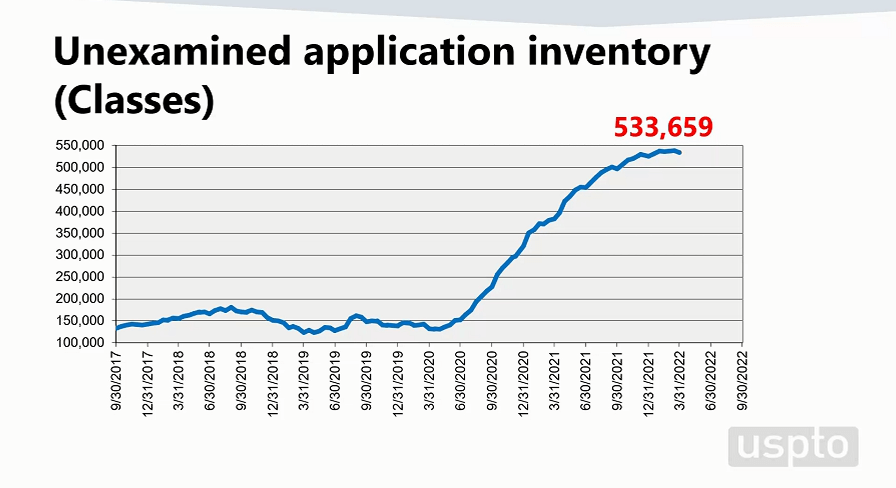
Pendency numbers are continuing to increase, however the numbers are beginning to level off. The disposal pendency goal is 13.5 months, and the USPTO is currently at 12.5 months. The USPTO hopes that the number will continue to go down. The USPTO reports that first action pendency has gone up a bit since February and is currently at 7.7 months, whereas the goal is to be at 7.5 months. The USPTO hopes that the number will level off and go below 7.5 months by the end of the fiscal year as a result of increased hiring and productivity and fewer trademark filings. The USPTO affirmed that it wants the first pendency number to go down over the next few years and that they are making efforts to reduce the number.
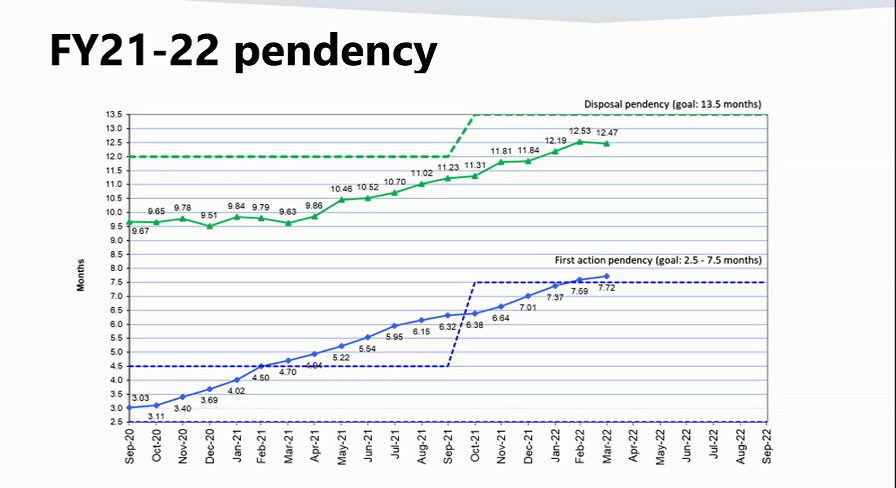
The USPTO noted that while productivity is important, the quality of the product is equally important; USPTO registration certificates should be as valuable as possible. The USPTO reported that it is continuing to meet all quality metrics: (1) First action compliance, (2) Final action compliance, and (3) Exceptional office actions. (1) and (2) look to whether the USPTO made the right decision on the case and (3) looks to whether office actions fully explain reasons for refusal and provide an appropriate amount of evidence to support those decisions.
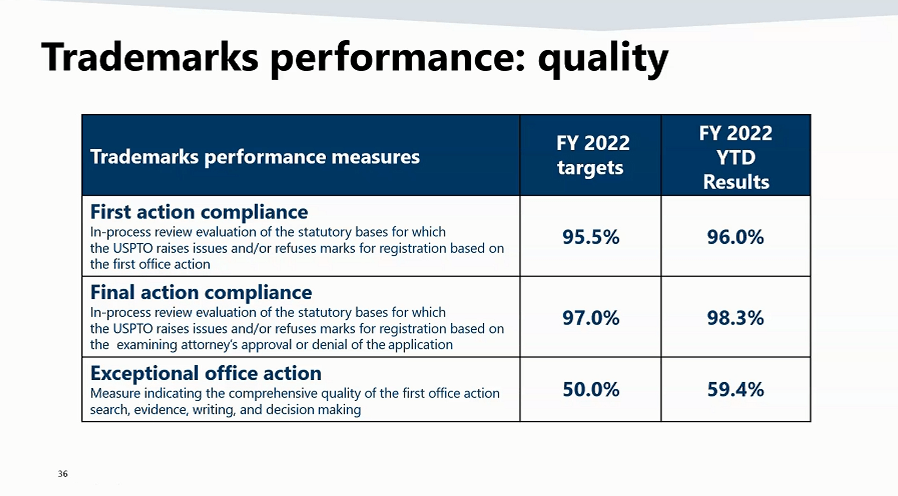
In terms of the current processing timelines, the USPTO is back on track with processing new applications and amendments after last year’s backlog. Currently, new applications and amendments are processed within one week. The USPTO acknowledged that it is still behind on processing post-registration maintenance filings. Currently, these filings are processed within 90 days and the USPTO is working on staff training, cross training, and other process improvements to get back up to speed. You can visit the USPTO’s dashboard to view current pendency times.
In order to improve pendency numbers, the USPTO continues to hire more staff. It hired 91 Examining Attorneys in FY2022; this is approximately a 15% increase in the current base number of Examining Attorneys and the USPTO expects to continue this level of hiring over the next few years. The USPTO noted that the Trademark Academy is a new model in place to help ensure that new Examining Attorneys are trained in a consistent manner. Additionally, TM Flex is a group of contractors who were brought in to help with bad faith investigations, collecting evidence for the sanctions process. Another important process in place is artificial intelligence (AI) and robotic process automation. These new tools are being used to help with design coding of new applications that come in and also to look at questionable addresses in bad faith investigations. Lastly, the USPTO has employed third parties to look at USPTO processes to look for inefficiencies.
Trademark Examination Policy Update
Deputy Commissioner for Trademark Examination Policy Amy Cotton provided an update on the way in which the USPTO is handling scams before the office. She identified the four main types of scams that the USPTO is seeing:
- Misleading customers to pay unnecessary services/inflated fees. The USPTO saw a huge win convicting a Latvian citizen of mail fraud after he used a QR code to link to USPTO site. His scam impacted 2,900 victims and enabled him to fraudulently receive $1.5-3 million. He was sent to jail and ordered to pay $4.2 million in restitution.
- Bad actors posing as USPTO. The USPTO put a stop to a ring of Pakistani websites soliciting low-cost filing services and claiming to be sponsored by the USPTO. These sites ended up filing incorrect information and used their own information for correspondent information. They would link to a fake USPTO fee portal, charging higher fees than the USPTO charges.
- Hijacking applications and registrations – Clone Scheme. The USPTO identified a Chinese entity that filed applications for famous marks, copying all information on the actual mark holders’ applications, except that they changed one letter in the email address. By redirecting emails, USPTO correspondence went to the Chinese entity. The purpose of the scheme was likely to try to get into eCommerce brand registry enrollments to try and take down competitors, even if only for a day or two.
- Scammers renting attorney credentials. The USPTO has entered sanctions against 14,000 registrations and applications in these schemes and attorneys involved are referred to the OED.
Commissioner Cotton identified several strategies that the USPTO has implemented to address scams:
- Reorganizing trademark registration system. The USPTO is in brand protection mode and is working hard to implement processes to address fraud. One example is that the USPTO set up an automated bot to query owner addresses against the US Postal Service’s database to see if address is improper and should be refused by Examining Attorney.
- Administrative sanctions. The USPTO has created a system to investigate and go after scammers and invalidate their applications.
- Communication with customers. As a result of the USPTO’s crackdown on fraud, many applications are being terminated and registrations are sanctioned. It’s imperative that the USPTO work to educate customers to explain what has happened and how to prevent it from happening in the future. The USPTO is working on outreach efforts through social media and has created a new page to educate customers about scams in a very accessible way.
- Access controls. The USPTO is actively working to implement ID verification.
- Post-registration audit and TMA nonuse proceedings. These new processes and tools are helping to protect the integrity of the register and clear the USPTO register of marks that never should have been registered in the first place due to scams/fraud in the application process. The USPTO recently delivered a webinar discussing TMA proceedings filed thus far and maintains a webpage detailing all of the TMA proceedings filed.